| Listing 1 - 10 of 13 | << page >> |
Sort by
|
Book
Year: 2005 Publisher: Copenhagen, Denmark : Nordic Council of Ministers,
Abstract | Keywords | Export | Availability | Bookmark
 Loading...
Loading...Choose an application
- Reference Manager
- EndNote
- RefWorks (Direct export to RefWorks)
The aim of the Nordic Arctic Research Programme (NARP) was to enhance Nordic competence and research co-operation in three priority areas: Natural Processes - Land, Sea and Atmosphere, Biological Diversity and Environmental Threats in the Arctic, and Living Conditions of the Inhabitants of the Arctic. In this publication, we introduce the programme and some research results as a series of short highlights provided by the project coordinators, to illustrate the diversity of the accomplishments by the Nordic Arctic scientific community. Outstanding work on a variety of Arctic issues has been done throughout the programme. The Nordic Arctic Research Programme supported especially networking and mobility between several research groups. A great number of young students have greatly benefited from their study visits in Nordic laboratories, and there is an urgent need to find funding for further collaboration. Also, co-operation with researchers from the Faroe Islands, Greenland and Iceland has increased during the programme. The programme included 63 projects focusing equally on the above-mentioned three priority areas. It has become clear during the course of the Nordic Arctic Research Programme that there is still an urgent need for multidisciplinary scientific Arctic studies in the future. Especially the trends and amplitudes of environmental change in the Arctic region are still poorly recorded, and many feedback processes of change are not fully understood. The rapidly changing socio-economic conditions in the Arctic require further scientific attention. More scientists and especially young talented people should be involved in Arctic science in the future. The programme was carried out during the period 1999-2003 and finalised in 2004. The annual budget was 6.2 million DKK, amounting to a total of 31 million. The programme hence provided a particularly good opportunity for Nordic cooperation and networking of research. The secretariat of the programme worked in Thule Institute at the University of Oulu. More information is available at http://thule.oulu.fi.
Book
ISBN: 9780822963226 0822963221 Year: 2005 Publisher: University of Pittsburgh Press
Abstract | Keywords | Export | Availability | Bookmark
 Loading...
Loading...Choose an application
- Reference Manager
- EndNote
- RefWorks (Direct export to RefWorks)
A central concern of nearly every environmental ethic is its desire to extend the scope of direct moral concern beyond human beings to plants, nonhuman animals, and the systems of which they are a part. Although nearly all environmental philosophies have long since rejected modernity's conception of individuals as isolated and independent substances, few have replaced this worldview with an alternative that is adequate to the organic, processive world in which we find ourselves. In this context, Brian G. Henning argues that the often overlooked work of Alfred North Whitehead has the potential to make a significant contribution to environmental ethics. Additionally inspired by classical American philosophers such as William James, John Dewey and Charles Sanders Pierce and environmental philosophers such as Aldo Leopold, Peter Singer, Albert Schweitzer, and Arne Naess, Henning develops an ethical theory of which the seminal insight is called "The Ethics of Creativity."By systematically examining and developing a conception of individuality that is equally at home with the microscopic world of subatomic events and the macroscopic world of ecosystems, The Ethics of Creativity correctly emphasizes the well-being of wholes, while not losing sight of the importance of the unique centers of value that constitute these wholes. In this way, The Ethics of Creativity has the potential to be a unique voice in contemporary moral philosophy.
Whitehead, Alfred North, 1861-1947 --- Ethics --- Environmental Ethics --- Environmental Responsibility --- Biography & Autobiography --- Philosophy --- Nature
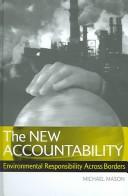
ISBN: 9786610476213 6000000294 1417589078 1280476214 1136553088 1849773149 9781849773140 9781844070664 1844070662 9781844070671 1844070670 9781136553080 9781417589074 9781280476211 113655307X Year: 2005 Publisher: London Sterling, VA EARTHSCAN
Abstract | Keywords | Export | Availability | Bookmark
 Loading...
Loading...Choose an application
- Reference Manager
- EndNote
- RefWorks (Direct export to RefWorks)
Annotation
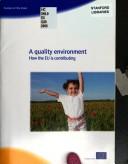
ISSN: 10228233 ISBN: 927900364X Year: 2005 Publisher: Luxembourg Office for official publications of the European communities
Abstract | Keywords | Export | Availability | Bookmark
 Loading...
Loading...Choose an application
- Reference Manager
- EndNote
- RefWorks (Direct export to RefWorks)
Environmental policy --- Conservation of natural resources --- Sustainable development --- Environmental responsibility --- Environnement --- Conservation des ressources naturelles --- Développement durable --- Responsabilité environnementale --- Politique gouvernementale --- Développement durable --- Responsabilité environnementale

ISBN: 1617700037 1423747607 9781423747604 9781617700033 1932716122 9781932716122 Year: 2005 Publisher: New York International Debate Education Association
Abstract | Keywords | Export | Availability | Bookmark
 Loading...
Loading...Choose an application
- Reference Manager
- EndNote
- RefWorks (Direct export to RefWorks)
Environmental education --- Environmental responsibility --- Ecological accountability --- Ecological responsibility --- Environmental accountability --- Environmental ethics --- Responsibility --- Education --- Activity programs in education --- Activity programs. --- Curricula. --- Study and teaching (Elementary)
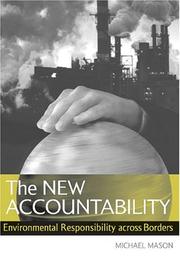
ISBN: 1844070670 1844070662 9781844070664 9781844070664 Year: 2005 Publisher: London Earthscan
Abstract | Keywords | Export | Availability | Bookmark
 Loading...
Loading...Choose an application
- Reference Manager
- EndNote
- RefWorks (Direct export to RefWorks)
"Drawing on case studies, this book provides a fresh understanding of democratic accountability for transboundary and global harm and argues that environmental responsibility should be established in open public discussions about harm and risk"--Provided by publisher.
#SBIB:327.7H42 --- #SBIB:35H434 --- Specifieke internationale organisaties en samenwerking: milieu --- Beleidssectoren: milieubeleid en ruimtelijke ordening --- Environmental policy --- Environmental protection --- Environmental responsibility --- Ecological accountability --- Ecological responsibility --- Environmental accountability --- Environmental ethics --- Responsibility --- International cooperation
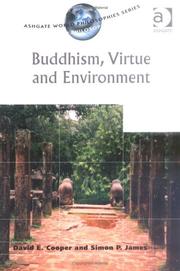
ISBN: 0754639096 075463910X 9780754639091 9780754639107 Year: 2005 Publisher: Aldershot Ashgate
Abstract | Keywords | Export | Availability | Bookmark
 Loading...
Loading...Choose an application
- Reference Manager
- EndNote
- RefWorks (Direct export to RefWorks)
Human ecology --- Virtues (Buddhism) --- Environmental ethics. --- Environmental responsibility. --- Nature --- Religious aspects --- Buddhism. --- Environmental ethics --- Environmental responsibility --- 294.35 --- 294.35 Boeddhisme: Dhamma--(morele wet) --- Boeddhisme: Dhamma--(morele wet) --- Buddhist virtues --- Buddhism --- Buddhist ethics --- Ethics --- Ecology --- Environment, Human --- Human beings --- Human environment --- Ecological engineering --- Human geography --- Ecological accountability --- Ecological responsibility --- Environmental accountability --- Responsibility --- Environmental quality --- Religious aspects&delete& --- Doctrines --- Social aspects --- Effect of environment on --- Effect of human beings on --- Moral and ethical aspects --- Human ecology - Religious aspects - Buddhism. --- Nature - Religious aspects - Buddhism.
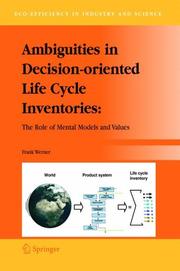
ISBN: 1280312777 9786610312771 1402032544 1402032536 9048168244 Year: 2005 Volume: v. 17 Publisher: Dordrecht : Springer Netherlands : Imprint: Springer,
Abstract | Keywords | Export | Availability | Bookmark
 Loading...
Loading...Choose an application
- Reference Manager
- EndNote
- RefWorks (Direct export to RefWorks)
In an environmental life cycle assessment of products (LCA), an unambiguous, scientifically based, ‘objective’ attribution of material and energy flows to a product is pure fiction. This is due to the fundamental epistemological conditions of LCA as a modelling process under the complexity of our socio-economic system. Instead, various mental models and values guide this attribution. This leads to a functional model in a specific decision situation. This book shows for the first time how mental models and values influence this attribution in the life cycle inventory step of LCA. One of the key findings is that the different management rules for a sustainable use of materials must be taken into account for the attribution of material and energy flows to a product. Otherwise, improvement options recommended by an LCA might turn out to even worsen the environmental situation if reassessed from a meta-perspective. As a consequence of this book, the claim of unambiguitiy (‘objectivity’) of the life cycle inventory must be abandoned. A group-model building process for LCA is developed that allows one to grasp the decision makers' mental models and values in the inventory analysis on a case- and situation-specific basis. Only by this, LCA results will become relevant in a decision-making process. Two case studies on the modelling of recycling and other end-of-life options of aluminium windows and beech wood railway sleepers in LCA complement the methodological part. This book is a ‘must have’ for researchers, consultants and practitioners in the fields of decision-oriented life cycle assessment as well as product-related environmental management, modelling and decision-making.
Environmental responsibility. --- Environmental management. --- Inventories. --- Environmental economics. --- Economics. --- Environmental Economics. --- Environmental Management. --- Environmental stewardship --- Stewardship, Environmental --- Environmental sciences --- Management --- Economics --- Environmental quality --- Environmental aspects --- Economic aspects --- Stock in trade --- Stock-taking --- Inventory control --- Ecological accountability --- Ecological responsibility --- Environmental accountability --- Environmental ethics --- Responsibility

ISBN: 0754637654 9780754637653 9781315263564 9781351961417 Year: 2005 Publisher: Aldershot Ashgate
Abstract | Keywords | Export | Availability | Bookmark
 Loading...
Loading...Choose an application
- Reference Manager
- EndNote
- RefWorks (Direct export to RefWorks)
Environmental responsibility --- Environmental policy --- Responsabilité environnementale --- Environnement --- International cooperation. --- Coopération internationale --- Politique gouvernementale --- World Environment Organization. --- #SBIB:327.7H42 --- Ecological accountability --- Ecological responsibility --- Environmental accountability --- Environmental ethics --- Responsibility --- Specifieke internationale organisaties en samenwerking: milieu --- Responsabilité environnementale --- Coopération internationale --- International cooperation
Book
ISSN: 16285409 ISBN: 2915552193 9782915552195 Year: 2005 Publisher: Dijon : E.U.D. (Editions universitaires de Dijon),
Abstract | Keywords | Export | Availability | Bookmark
 Loading...
Loading...Choose an application
- Reference Manager
- EndNote
- RefWorks (Direct export to RefWorks)
Precautionary principle --- Environmental responsibility --- Environmental protection --- Principe de précaution --- Responsabilité environnementale --- Environnement --- Congresses --- Congrès --- Protection --- Liability for environmental damages --- Environmental risk assessment --- Law and legislation --- Principe de précaution --- Responsabilité environnementale --- Congrès --- Precautionary principle - France - Congresses --- Liability for environmental damages - France - Congresses --- Environmental risk assessment - Law and legislation - France - Congresses --- Principe de precaution --- Evaluation du risque --- France
| Listing 1 - 10 of 13 | << page >> |
Sort by
|

 Search
Search Feedback
Feedback About
About Help
Help News
News